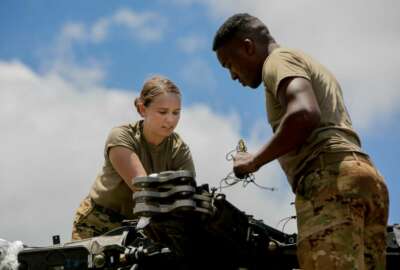Soldiers expecting more changes in the way they can dress or appear in uniform won’t be getting much more from the Army in the near future.
That dashes hopes of some soldiers hoping to make beards more accessible outside of having a medical waiver. The changes this year gave hope to some soldiers that more overhauls were on the way.
Sergeant Major of the Army Michael Grinston said the Army does not have any major changes to standards coming up in the pipeline, a direct contrast to the changes this year.
“I think there’s going to be a few minor tweaks here and there,” Grinston told reporters Thursday during a Defense Writers Group roundtable. “Right now I don’t see us making any bold moves or any changes.”
The Army has been reviewing many of its policies in order to rethink its retainment and recruitment strategies for the next generation and to encompass a more diverse populace.
In January, the Army made a drastic change to its grooming standards by allowing certain hairstyles, jewelry, makeup and other accessories.
“We’ve been going through all of the regulations to figure out how can we improve the standards and policies that we have to make sure that they are fair and equitable for all soldiers, and so that we can obviously get the best talent in the Army,” Sgt. Maj. Brian Sanders of the Uniform Policy Branch told reporters at the beginning of the year.
The changes are due to a number of factors, including the fact that standards were physically harmful to a certain gender, occupation or culture.
For example, the Army will allow women to wear long ponytails instead of putting their hair in tight buns.
“The dermatologists really played a big part in this one,” Sanders said. “It is still professional and neat and it doesn’t impair or impede the proper wear of any Army head gear. From the dermatology perspective, if you look at hair loss, forcing hair into this tight bun leads to more hair loss and to traction alopecia, and a lot of other scarring and medical conditions of the scalp. What we’re trying to do is get to low risk of hair loss for female soldiers and provide a better quality of life.”
Women also reported migraines and headaches from tight buns.
Grinston said buns were a readiness issue as well. Women reported buns pushing helmets forward and obstructing eyesight in training exercises.
The Army furthered that policy in May by authorizing all women in all uniforms to wear ponytails.
It’s not just for utility that the Army changed some of the policies, though.
Women can wear earrings in non-combat environments. One exception is that pearl earrings may only be worn in a dress capacity.
“We’ve learned some different things that may impact female soldiers in reference to being a female in a masculine Army,” Sanders said. “Our attrition rates for females are higher than males, and as we started looking into those things, we realized that they need to feel like a female and be a soldier at the same time. Earrings help bridge the gap. This can impact individuals who may be feeling depressed because they don’t feel like a female.”
Grinston pointed out the importance of diversity in the Army as a means for making the service better.
He pointed to times when the Army had people who spoke Pashto in its ranks and it helped the service with intelligence in the Middle East or, when the Ebola crisis hit Africa, the Army could call on people it employed to provide local knowledge.
Copyright
© 2024 Federal News Network. All rights reserved. This website is not intended for users located within the European Economic Area.
